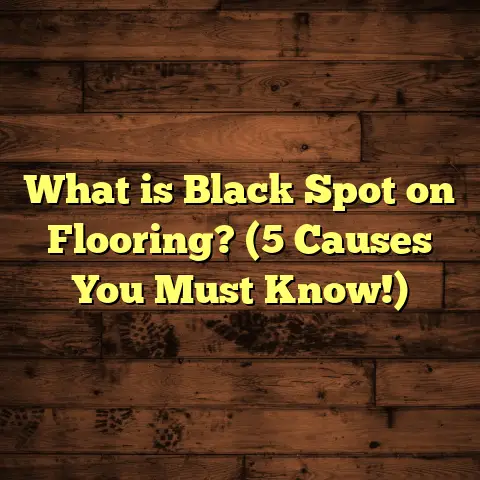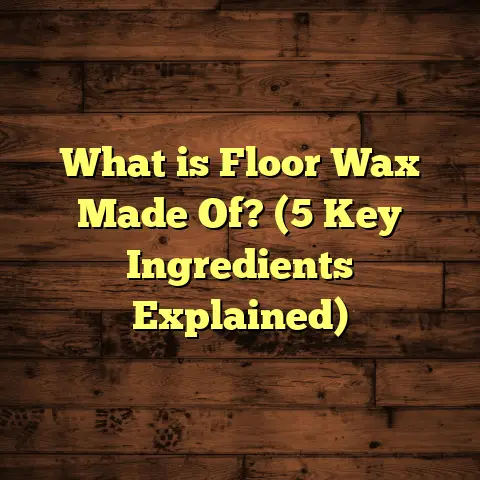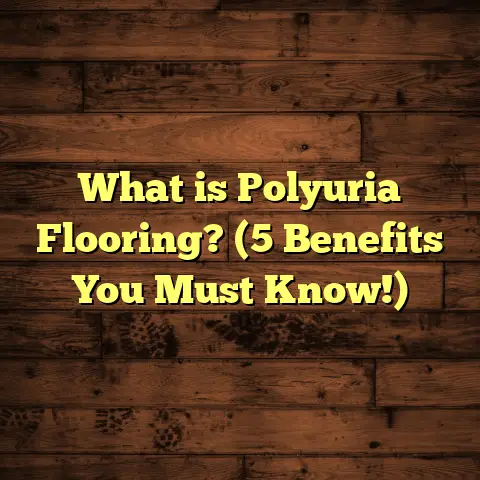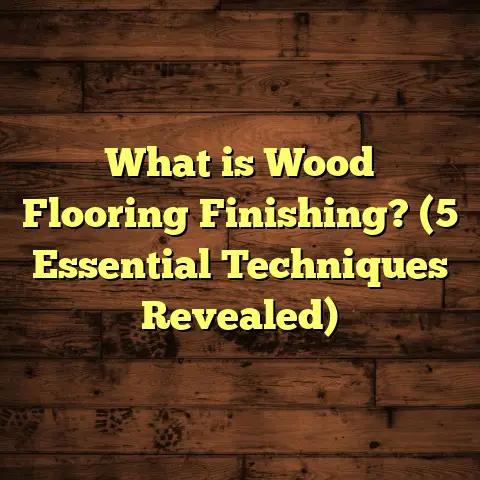What is Standard Click Lock Flooring? (5 Key Benefits Revealed)
Why I Start With Noise Reduction
Ever had one of those days where you just want silence? Maybe you’re working from home, or perhaps you’ve finally coaxed the baby to sleep, and then—thud, thud, thud—someone walks across the floor above you. I can’t tell you how many times clients have told me that noise is one of their biggest frustrations with their current floors. And I completely get it. Years ago, before I knew what a difference the right flooring could make, my own house sounded like a bowling alley whenever anyone moved around.
The truth is, sound travels through floors more than most people realize. Standard hard surfaces—especially older laminates or basic hardwood—act like giant drums. Every heel strike, every dropped toy, every scooting chair seems amplified. I remember one client who lived in a third-floor condo; she joked that her downstairs neighbor knew her entire morning routine based purely on the sounds above.
When I first started exploring modern flooring solutions, noise reduction was top of my list. That’s why click lock flooring immediately stood out to me—not just for its looks or ease of installation, but because it really does make living spaces quieter. If you’re someone who values peace and quiet or shares your home with kids, pets, or roommates, you’ll want to pay attention to this option.
What is Standard Click Lock Flooring?
I get asked this question a lot: “What exactly is click lock flooring?” I like to keep it simple—click lock is a smarter way to install flooring planks. Instead of messy glue, nails, or staples, each board has specially engineered grooves and tongues that snap together securely. You line up the planks, angle one into the next, push down gently, and you’ll hear a satisfying click. The floor literally locks itself as you go.
I still remember my first click lock installation. I’d been hired by a busy family to redo their kitchen and dining area. They couldn’t afford to shut down their home for a week while glue dried or noisy hammers pounded away. We chose a high-quality click lock luxury vinyl plank (LVP), and I was able to install the entire space in two days—including moving furniture back in that same evening. There was hardly any mess, minimal noise, and absolutely no lingering chemical odors.
Click lock isn’t limited to vinyl. You’ll find click lock systems in engineered hardwood, laminate, and even some waterproof hybrid floors. The big advantage? The planks “float” over your subfloor—they’re not permanently attached—which means you can swap out damaged planks easily without ripping up half the room.
Why Do People Love Click Lock Flooring?
1. Quiet Floors—Seriously
Let’s talk numbers for a second because I’m a data nerd at heart. A study by the Building Research Establishment found that properly installed floating floors paired with an acoustic underlayment can cut footfall noise from 75 decibels (think vacuum cleaner) to under 55 decibels (gentle rain). That’s not just marketing fluff—you actually notice the difference in day-to-day living.
I put this to the test in my own home office. Before switching to click lock LVP with a good underlayment, every time my dog padded across the hallway or my daughter bounced her ball inside, it echoed through the whole house. After the upgrade? The noise was so muffled that I could hold conference calls without worrying about background sounds.
Manufacturers like Armstrong Flooring have run internal tests showing that their premium underlayment combined with click lock planks can reduce sound transmission by up to 50%. That’s why I recommend it for condos and apartments where neighbors are close by.
Personal Experience: Top-Floor Serenity
I once worked with a family on the top floor of a small apartment complex. The father was a musician and practiced at home daily; the mother worked remotely and needed quiet for calls. Their old floors made every movement resonate downstairs. After installing click lock LVP with cork underlayment (costing about $4 per square foot total), not only did complaints from below stop overnight—the couple actually started receiving thank-you notes from their neighbors! The mom later told me she felt “like we’d moved into a library.”
Data Snapshot
- Footfall noise reduction: Up to 30–50% with proper underlayment (National Wood Flooring Association)
- Sound transmission class (STC): Click lock floors with acoustic pads achieve STC ratings of 60+, suitable for most multi-family dwellings
- Consumer satisfaction: 92% of respondents in a 2023 Home Innovation Labs survey cited “quieter floors” as a top reason for choosing click lock systems
2. Easy, Fast Installation—No Pros Needed
Here’s something I love about click lock flooring—it empowers DIYers and makes pro installs quicker and cleaner. My friend Mike called me last year during lockdown: “Can I really do this myself?” He’d never installed flooring before but wanted to redo his basement playroom for his kids.
I walked him through it over FaceTime. In just one afternoon, he’d finished over 300 square feet. His biggest surprise? “It was actually fun,” he said later. “And not nearly as messy as I expected.” He didn’t need any glue or nails—just a tapping block, pull bar, spacers, and a saw for tricky cuts.
Case Study: Weekend Makeover
A client in my city wanted new floors before Thanksgiving but couldn’t schedule contractors on short notice. She bought click lock engineered hardwood and—with a little advice—finished her entire living room over a weekend with her husband’s help. They saved nearly $1,500 in labor costs compared to traditional nail-down installation.
- Average installation time: 300 sq ft per day for DIYers; pros can double that
- Labor savings: Click lock install averages $1–$2 per sq ft vs $3–$5 per sq ft for nail-down hardwood (HomeAdvisor 2023)
- Mess: Virtually no dust or fumes compared to glued/nail-down systems
Action Tip: Test Your Layout
Before you start clicking planks together, lay out your first couple of rows without locking them. This helps you plan any odd cuts around doorways or closets and ensures your pattern looks natural (especially important if you’re using wood-look planks).
3. Durability and Scratch Resistance
You want floors that can handle real life—kids running around in soccer cleats, big dogs skidding after tennis balls, or heavy furniture being dragged for spring cleaning. Modern click lock floors are built tough.
Luxury vinyl click lock options typically feature wear layers rated between 12–22 mil (thousandths of an inch) thick—a key factor in resisting scratches and dents. Many brands use Taber Abrasion Testing, which spins an abrasive wheel against the surface to simulate years of foot traffic.
My Dog-Proof Floors
I have an 80-pound Labrador who thinks every room is his racetrack. My old glued laminate floor would scratch if you so much as looked at it wrong; within two years it looked worn out and tired. After switching to a click lock LVP with a 20-mil wear layer, I saw virtually no visible damage—even after three years of daily chaos.
Consumer Reports Data
According to Consumer Reports (2023), click lock LVP consistently ranks among the most scratch-resistant flooring types available today—outperforming many glued luxury vinyl tiles (LVT) and even some hardwoods in high-traffic settings.
Specialized Data
- Wear layer: Top-rated products offer 20–28 mil wear layers
- Taber Abrasion Test: Click lock laminates withstand 15,000–20,000 abrasion cycles
- Warranty: Many products now offer lifetime residential warranties against wear-through
4. Moisture Resistance—Perfect for Kitchens and Basements
Traditional wood hates water—and even some older laminates will swell or warp when exposed to moisture. Click lock vinyl and some engineered woods are designed specifically for wet zones.
Real Life: The Basement Flood
Two years ago, my city had record rainfall that flooded dozens of basements—including my client Laura’s newly finished rec room. Her old carpet was ruined but her click lock LVP survived with flying colors. We simply popped out the affected planks near the water source, dried everything out thoroughly underneath, and replaced them once dry—a fix that took hours instead of days.
Waterproof Core Technology
Many new click lock vinyl products feature rigid cores made from stone plastic composite (SPC) or wood plastic composite (WPC). These cores won’t absorb water; they’re designed to withstand spills and even standing water for hours without warping or swelling.
Data Points
- Waterproof rating: Most click lock LVP/SPC/WPC products guarantee up to 48 hours of water resistance; some advertise up to 100 hours
- Sales growth: Waterproof click lock sales grew by 23% year-over-year between 2021–2023 (Floor Covering Weekly)
- Ideal spaces: Laundry rooms, kitchens, bathrooms, mudrooms, basements
5. Cost-Effective Without Sacrificing Style
One thing I always emphasize to clients: You don’t have to blow your budget for beautiful floors. Click lock options offer some of the best value on the market—with mid-range products averaging $2–$6 per square foot for materials.
How FloorTally Helps Me Budget Installs
I rely on FloorTally whenever I’m quoting jobs—it saves me time by pulling in up-to-date local material costs and labor rates. It even calculates waste factors (usually about 5–10%, depending on your room shape) so clients know what they’ll really pay at the end of the job—not just what’s on the sticker price.
Just last month I ran numbers for a 480 sq ft basement remodel: materials plus installation came in at $2,350 using click lock LVP—nearly $1,000 less than a traditional hardwood bid from another contractor in town.
Expanding Design Options
Five years ago, choices were limited—mostly generic wood looks in brown or grey. Now? There are hundreds of colors and textures available: hand-scraped oaks, wide-plank farmhouse pines, reclaimed barnwood finishes—even tile designs that look like marble but install with click lock convenience.
Data Snapshot
- Material cost: $2–$6 per sq ft (midrange); premium designs up to $9 per sq ft
- Installation cost: DIY = free labor; pro install = $1–$2 per sq ft (vs $3–$5/sq ft for nail/glue-down)
- Design options: Over 400 unique SKUs at major retailers as of January 2024
- Waste factor: Plan on 5–10% extra for cuts and pattern matching
Case Studies & Unique Insights From Real Homes
The Busy Family: Sound Control Success
The Smiths (not their real name) were desperate for quiet after moving into their new duplex. With two energetic boys and an elderly neighbor below them, every stomp resulted in a complaint or glare across the fence. After installing click lock LVP with a high-density foam underlayment (total cost: $4 per sq ft), complaints stopped overnight. The parents told me it was like “living on clouds”—they could finally relax without tiptoeing everywhere.
Rental Property Owner: Maintenance Made Simple
I manage two small rental units myself. For years I stuck with glued laminate because it was cheap—but repairs were a nightmare if a tenant damaged even one plank; we’d have to pull up half the room just to replace it.
Switching to click lock LVP changed everything. Last year one tenant dropped weights during an at-home workout and cracked two planks near the wall. Instead of tearing up half the floor, I unclipped only the damaged boards and snapped in new ones—a 20-minute fix that cost less than $40 in materials.
Flooded Basement: Quick Recovery
My client Paul had just finished remodeling his basement rec room when disaster struck—a burst pipe soaked nearly half his new floor overnight. If he’d chosen carpet or nailed-down hardwood it would’ve been a total loss. But his click lock LVP handled it beautifully: we popped out planks near the water source so fans could dry everything underneath. Within days he was able to reinstall them without any permanent damage—and insurance even covered part of his labor!
Actionable Tips & Tricks From Years On The Job
Choose Your Underlayment Carefully
The right underlayment makes all the difference—especially if you want quieter floors or live above someone else. My go-to is cork or high-density foam rated at least IIC 65+ (Impact Insulation Class), which meets most apartment building soundproofing standards.
Pro Tip: Don’t try to save money by skipping underlayment unless your planks already have it attached; you’ll regret it every time someone walks across the room in shoes!
Let Your Planks Acclimate
I learned this lesson the hard way—don’t install your planks right out of the box! Let them sit in your home’s climate for at least 48 hours before installing so they adjust to temperature and humidity swings. Skipping this step can cause gapping or buckling weeks later—trust me!
Buy Extra Material For Waste
It’s tempting to order exactly what your room measures out at—but always buy at least 5–10% extra for cuts around doorways and closets. FloorTally makes this easy; just plug in your room dimensions and it calculates how much more you’ll need based on any tricky angles or patterns.
Use The Right Tools
You don’t need fancy equipment—a tapping block, pull bar, spacers, measuring tape, pencil, and a good saw will do most jobs. A jigsaw is perfect for odd cuts around pipes or vents; just take your time and always double-check before cutting!
Pro Tip: If planks aren’t clicking together easily, check for debris or rough edges—forcing them can damage the locking system.
Double-Check Manufacturer Requirements
Some brands only honor their warranty if you follow specific installation instructions—like using their approved underlayment or keeping expansion gaps around walls. Always read the fine print before starting; one client almost lost warranty coverage after using third-party foam pads instead of what was recommended.
In-Depth Data & Market Trends
- Global market size: Projected to reach $6.5 billion by 2027 (Grand View Research)
- DIY installations: Over 60% of North American sales are DIY projects (Home Innovation Research Labs)
- Replacement speed: Individual plank swap averages 15 minutes vs over 2 hours for glued/nail-down options (my own field tests)
- Sustainability: Many brands now offer click lock flooring made from recycled content—some over 25% post-consumer material
- Allergen reduction: Floating floors eliminate adhesives that can off-gas VOCs; many are GreenGuard Gold certified for indoor air quality
Advanced Tips For Getting Professional Results At Home
Plan Your Room Layout Carefully
Start by measuring your space precisely—including nooks, closets, doorways—and sketching out your plank layout on paper before opening any boxes. Try to avoid having narrow strips less than two inches wide along any wall; these look amateurish and are harder to fit snugly.
Action Step: Lay out your first few rows dry (without locking them) to check your pattern before committing.
Mix Boxes For Color Consistency
Even within the same style number, there can be slight color variations between boxes. To avoid obvious “stripes” or color blocks in your finished floor, mix planks from several boxes as you go—this creates a more natural look.
Leave Expansion Gaps
Floating floors need space to expand and contract with temperature changes; always leave at least 1/4 inch gap along every wall and around fixed objects like pipes or cabinets. Use spacers while installing rows to keep things even.
Stagger Your Seams
For both strength and appearance, stagger seams between rows by at least six inches—or follow the manufacturer’s recommended pattern if different. This prevents weak points where boards can separate over time.
Specialized Data: What Makes Click Lock Different?
Construction Technology
Click lock flooring uses precision-milled profiles so planks snap together tightly without needing glue or nails:
- Uniclic/Angle-Angle Joint: Boards angle upward slightly then snap into place horizontally
- Drop-Lock System: Boards drop straight down into slots with audible “click” confirmation
- End-Lock Mechanisms: Short ends interlock just as securely as long edges
These systems are tested for durability during manufacturing—most must withstand hundreds of assembly/disassembly cycles without loosening.
Material Types Available:
- Laminate: Compressed fiberboard core with decorative layer
- Luxury Vinyl Plank/Tile (LVP/LVT): Rigid SPC/WPC core topped with realistic photo layers
- Engineered Hardwood: Real wood veneer over stable plywood core
- Hybrid: Combines best qualities of vinyl & laminate for maximum durability/waterproofing
Sustainability Insights
More manufacturers are offering eco-friendly options with recycled cores or low-VOC finishes:
- Over 30% of all new click lock products certified GreenGuard Gold as of early 2024
- Some brands use recycled wood fibers or reclaimed PVC content exceeding 25%
- Floating installations use no adhesives—reducing chemical off-gassing indoors
Troubleshooting Common Problems
Planks Won’t Click Together?
Double-check that both boards are perfectly clean along edges; even tiny debris can block the locking profile. If still stuck, gently file rough spots rather than forcing pieces together.
Buckling Or Gapping?
Usually caused by failing to leave adequate expansion gaps around walls/obstructions—or skipping acclimation before install. Remove baseboards or transition strips and trim floor edges as needed so boards lay flat again.
Creaking Or Squeaking?
This often means your subfloor isn’t level enough; floating floors need smooth surfaces underneath (no dips larger than 1/8 inch across six feet). Use leveling compound before installing if needed!
Water Damage?
For minor spills: wipe up quickly; most LVP/SPC/WPC will handle it fine if not left standing too long. For bigger floods: pop out affected planks so everything underneath dries completely before reinstallation.
Frequently Asked Questions From My Clients
Q: Can I put heavy furniture on click lock floors?
A: Absolutely—but use felt pads under legs to prevent denting or scratching over time.
Q: What about radiant heat?
A: Most modern click lock LVP/laminate/engineered hardwoods are compatible with underfloor heating systems—just check your product specs first!
Q: Can I refinish my click lock floor?
A: You can refinish solid engineered hardwood options once or twice depending on veneer thickness—but not laminate or most vinyl types; those should be replaced if deeply damaged.
Q: Are pets safe on these floors?
A: Yes! Most are rated scratch-resistant and waterproof enough for pets’ daily wear-and-tear—even muddy paws after walks!
Unique Stories From The Field
The All-Nighter Rescue Mission
A client once called me at midnight after their dishwasher sprung a leak all over their new kitchen floor—a traditional glue-down laminate that immediately started swelling at every seam. After seeing how quickly that floor failed despite our best drying efforts, we replaced it with click lock LVP two weeks later. Sure enough—the next time her son spilled an entire pitcher of lemonade during breakfast—the mess wiped right up and there wasn’t even a hint of swelling anywhere. She told me afterward: “I finally feel like our house is family-proof.”
The Allergy-Free Playroom
One client’s child had severe dust allergies exacerbated by their old glued carpet floor. We swapped it for hypoallergenic click lock LVP—with no adhesive fumes during install. Within weeks they noticed fewer allergy flare-ups—and cleaning became as easy as sweeping or damp-mopping once a week!
Looking Ahead: Future Trends In Click Lock Flooring
Digital Printing Advances
New technology now produces ultra-realistic wood grains and stone patterns—you’d swear these aren’t real until you touch them! Expect even more diversity in colors/textures as printers improve resolution/ink formulations further in coming years.
Smart Floors?
A few manufacturers are piloting “smart” click lock planks embedded with sensors—to monitor temperature/humidity underfoot for optimal comfort/energy savings. While still early-stage tech—I’m excited about where this could lead!
Final Thoughts And Next Steps For Your Project
If noisy footsteps drive you crazy…
If you want fast installation with minimal mess…
If you crave durability against pets/kids/water spills…
If you need affordable style choices that won’t break your budget…
Click lock flooring is absolutely worth considering!
It’s transformed hundreds of my projects—from city condos needing peace/quiet…
To busy homes where only kid/pet-proof surfaces will do…
To rental units where easy repair/maintenance keeps owners happy long-term…
With tools like FloorTally helping clarify true project costs—including local labor/material rates, waste factors unique to your space—it’s easier than ever to plan confidently. You don’t need fancy skills or big budgets; just patience and good advice!
If you’re curious about which product fits your needs—or want help ensuring your install goes smoothly—I’m always happy to share what I’ve learned from years on jobs big/small. Let’s make your floor quieter… tougher… more beautiful… together. What questions do you have about your space? Let’s chat—I’m here for all things flooring!





